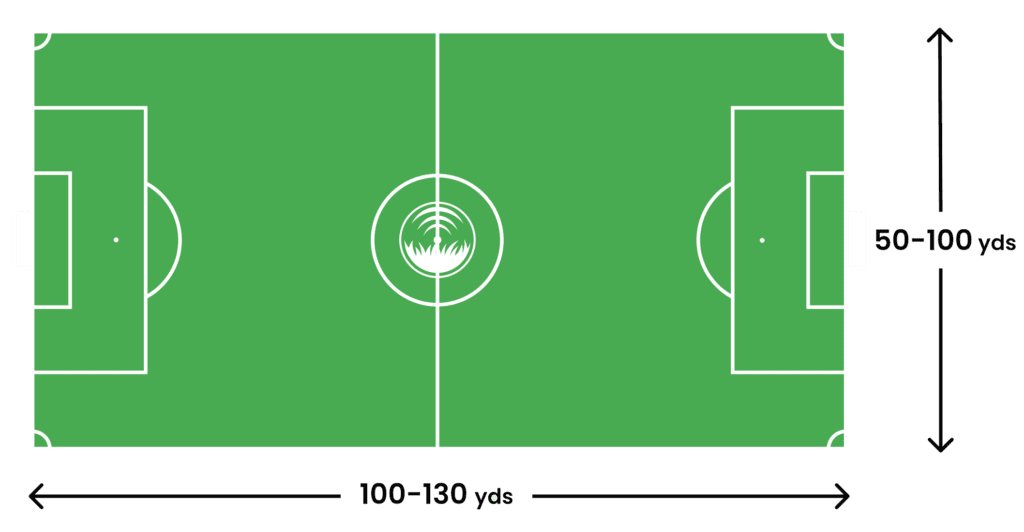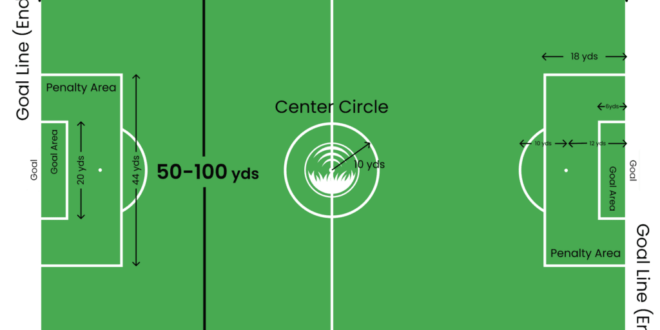A soccer field, also known as a football pitch, measures approximately 100 to 110 meters long and 64 to 75 meters wide. According to FIFA regulations, this size can slightly vary for international matches.
Understanding the dimensions of a soccer field is crucial for players, coaches, and fans alike. The playing surface, a critical component of the world’s most popular sport, adheres to standardized measurements to ensure fair play globally. These dimensions cater to the dynamic nature of the game, giving players ample space for strategy and skill execution.
Coaches tailor their tactics to the playing area, and fans may better appreciate the athleticism displayed on a field of this size. Whether it’s for organizing a local tournament or constructing a new venue, knowledge of soccer field dimensions ensures the integrity of the game is maintained.
🔴How Big is a Soccer Field🔴
Table of Contents
Soccer Field Dimensions
A soccer field, or pitch, is a large grassy area where the sport takes place. Its size varies by level of play. Fields have specific length and width dimensions. These dimensions set the stage for the game. Knowing the size of the field is crucial for players and coaches alike.
Minimum And Maximum Sizes
Soccer fields must fall within certain measurements. These vary for international, professional, and youth play. The minimum length for a soccer field is 100 yards (90 meters). The maximum length is 130 yards (120 meters). Width-wise, the field must be at least 50 yards (45 meters) wide, and not exceed 100 yards (90 meters). These numbers ensure a standardized playing area worldwide.
| Field Type | Minimum Length (yards/meters) | Maximum Length (yards/meters) | Minimum Width (yards/meters) | Maximum Width (yards/meters) |
|---|---|---|---|---|
| International | 110/100 | 120/110 | 70/64 | 80/75 |
| Professional | 100/90 | 130/120 | 50/45 | 100/90 |
| Youth | 50/45 | 100/90 | 50/45 | 100/90 |
Comparison To American Football Fields
The American football field measures 120 yards (110 meters) long and 53.3 yards (48.8 meters) wide. Soccer fields can be longer and wider. They have a wider range in size. Unlike soccer, an American football field’s size is fixed. It does not change across different levels of the sport. A soccer field could fit an American football field, with extra space on the sides or ends.
- American Football: Fixed 120 yards long by 53.3 yards wide
- Soccer: Ranges from 100 to 130 yards long and 50 to 100 yards wide
Regulatory Guidelines
Understanding the size of a soccer field is vital for players, coaches, and fans. It affects how the game unfolds. Fields must adhere to specific guidelines to ensure fair play. Let’s dive into the regulations that dictate the dimensions of the beautiful game’s playing field.
Fifa Standards
The global soccer authority, FIFA, sets forth strict criteria. These apply to all professional matches under its jurisdiction. Below are key points regarding FIFA’s field dimension standards:
- Length: Minimum of 100 meters, maximum of 110 meters
- Width: Minimum of 64 meters, maximum of 75 meters
- Markings: Clear lines must mark the field
- Goal Size: 7.32 meters wide by 2.44 meters high
- Penalty Area: 18.32 meters from the inside of each goalpost
Variations Across Leagues And Levels
Soccer fields can vary notably in size. These differences reflect various league standards and levels of play. Youth leagues, amateur competitions, and some professional leagues may not strictly follow FIFA’s guidelines. Consider these common variations:
| Level | Length (meters) | Width (meters) |
|---|---|---|
| Youth U-6 | 15–20 | 10–15 |
| Youth U-8 | 20–25 | 15–20 |
| Youth U-10 | 45 – 55 | 35 to 45 |
| High School | 90 – 120 | 45 to 55 |
| College | 100 – 110 | 64 – 75 |
Certain factors contribute to these variations. These include space constraints and the level of player development. Younger players benefit from smaller fields. This promotes more touches on the ball and involvement in the game.
Soccer Pitch Markings
Let’s walk onto the soccer field and explore the all-important soccer pitch markings. These lines and boxes might seem simple. Yet, they play a crucial role in the game of soccer.
The Role Of Lines And Boxes
Every soccer field bears lines and boxes with specific functions. Boundary lines, which encircle the entire field, keep the game in play. Markings like the center circle and the halfway line divide the field and facilitate kickoff procedures. Touchlines and goal lines determine the length and width of the field. These elements together create a standardized pitch for players across the world.
Understanding The Goal Area And Penalty Area
The goal area and penalty area are critical to the game’s rules and flow. The goal area, a small box in front of the goal, marks where a goalkeeper can handle the ball. It also guides where a goal kicks off. The penalty area affects gameplay significantly. Fouls here can award a penalty kick to the attacking team. Understanding these key areas is essential for players and fans alike.
The goal area, commonly referred to as the six-yard box, measures 6 yards from the goalposts and extends 6 yards into the field. The penalty area, a larger box, spans 18 yards from the goalposts and reaches 18 yards into the field. Here’s a simplified breakdown:
| Area | Size | Purpose |
|---|---|---|
| Goal Area | 6 yards x 20 yards | Goalkeeper ball handling, goal kicks |
| Penalty Area | 18 yards x 44 yards | Penalty kicks, goalkeeper privileges |
Additionally, within the penalty area, the penalty spot is located 12 yards from the goal. It is the point from which penalty kicks are taken. Surrounding the penalty area is the penalty arc. This semi-circle ensures that players remain a set distance away during penalty kicks. By learning these markings, fans, and players can grasp the pivotal events of the game that can occur within these boundaries.

Influential Factors On Size
When we talk about soccer fields, size can vary. Multiple factors influence how big a soccer field can be. From the age of the players to the type of tournament, each field adjusts for the game. Let’s dive into what shapes the soccer field dimensions.
Youth Soccer Adjustments
Young players need smaller fields. This makes soccer fun and safe for them. The size changes based on their age. Small fields help them learn and keep up with the game. Table 1 shows typical adjustments:
| Age Group | Field Size (Length x Width) |
|---|---|
| Under 6 | 15-20 yd. x 25-30 yd |
| Under 8 | 20–25 yd. x 30–40 yd |
| Under 10 | 25-35 yd. x 45-55 yd |
| Under 12 | 30-40 yd x 50-60 yd |
| Under 14 | 45-60 yd. x 70-80 yd |
Impact Of Venue And Event
- Different events mean different field sizes. Big tournaments might need larger fields.
- Local games can use smaller fields to fit venues.
- International games follow strict size rules.
Think of the World Cup. Here, fields must be within FIFA’s size range. A World Cup field will be 100–110 meters long and 64–75 meters wide. Venues must be adjusted for these events.
Whether it’s a youth league or the World Cup, field size impacts the sport. Knowing these influential factors helps us understand the game better.
Natural vs. artificial Turf
Soccer fields come in all shapes and sizes. The type of turf used can affect the game in many ways. Natural grass or artificial turf each offer unique benefits. Both have distinct features that influence gameplay, athlete safety, and field maintenance.
Effects On Playable Area
The surface of a field plays a critical role in how a game unfolds. Natural grass fields may vary depending on weather and use. Artificial turf offers consistent playability.
- Bounce: The ball may bounce differently on each surface.
- Speed: Players find artificial turf to be faster.
- Space: The dimensions of the field are not affected by the turf type.
Maintenance Differences
Natural and artificial fields need different care to stay game-ready. Proper upkeep is essential for safety and play quality.
| Turf Type | Maintenance Requirement |
|---|---|
| Natural Grass |
|
| Artificial Turf |
|
The upkeep of artificial turf tends to be more technical.
It may result in higher upfront costs but lower expenses over time.
On the other hand, natural grass demands regular horticultural attention. It could mean more frequent costs over its lifespan.
The Historical Evolution
The historical evolution of soccer fields is as dynamic as the sport itself. From humble beginnings, the size and layout of soccer fields have transformed. These changes reflect the evolving nature of the game and its rules.
Changes In Size Over Time
Initially, there were no fixed dimensions for a soccer field. Teams would play on any available space. In 1863, the first set of standardized rules introduced a rectangular shape. Still, sizes varied widely.
By 1887, dimensions were regulated, but alterations to these standards occurred. Over the years, governing bodies adjusted field sizes to optimize play. Today, fields must fall within specific measurements. The length ranges from 100 to 110 meters and the width from 64 to 75 meters.
Factors Influencing Regulations
- Gameplay Style: As soccer tactics evolved, so did field dimensions to facilitate different styles of play.
- Safety Concerns: Larger playing areas were enforced to reduce player injuries.
- Technological Advances: Technologies like drainage systems influenced the maintainability of larger fields.
- Viewer Experience: Stadium design and spectator visibility affected regulation sizes to ensure a better viewing experience.
Changes in regulations reflect soccer’s adaptation to modern demands, ensuring the game remains fair and exciting for players and fans alike.
International Variations
Soccer fans around the globe recognize that pitch sizes vary across international competitions. While FIFA sets standard guidelines, local factors and stadium requirements lead to interesting variations. Understanding these differences helps fans appreciate the diverse playing conditions teams adapt to in international play.
Country-specific Sizes
Soccer fields are not one-size-fits-all. Depending on the country, you can see distinct sizes. For instance:
- England: Premier League pitches can range from 100-110 meters in length and 64-75 meters in width.
- Italy: Serie A fields often measure up to 105 meters by 68 meters, closely aligning with FIFA’s preferred size.
- Brazil: Brazilian stadiums might adjust dimensions for a unique style of play, keeping within FIFA’s minimum and maximum requirements.
Adaptations For Multi-use Stadiums
Multi-use stadiums must balance soccer with other events. These adapt for sports like football or concerts. Consequently, fields here often fit within the smaller range of FIFA’s size regulations:
- Minimum length adjusts to ensure other events fit.
- Width is often reduced for additional seating or equipment.
- Grass types can change to accommodate various activities.
Hosting a soccer game one day and a rock concert the next calls for a smart design. This flexibility ensures non-stop action for fans.
| Country | Field Size (Length x Width) |
|---|---|
| USA | 110m x 70m (multi-sport adjustments) |
| Australia | 105m x 68m (cricket outfield considerations) |
| Canada | 100m x 65m (Canadian football integration) |

Practical Implications
The size of a soccer field can affect many aspects of the game. It influences how players and coaches approach practice and matches. Understanding these effects can lead to better strategies.
Influence On Playing Style
Teams use field size to their advantage. A vast field allows more room for long passes and fast play. With more space, teams can spread out, making quick attacks. Compact fields require tight ball control and tactical teamwork.
- Large fields: favor speed and endurance
- Small fields: emphasize skill and strategy
Preparation For Coaches And Players
Preparation is key to success. Coaches must tailor training sessions based on field dimensions. They plan drills, simulate match conditions, and create game plans.
| Field Size | Training Focus |
|---|---|
| Large | Stamina, long-range passing |
| Small | Positioning, quick passing |
Players adapt to different fields through practice. They learn to manage space, pace, and position themselves effectively. Fitness routines align with the demands of the field size.

Frequently Asked Questions For How Big Is A Soccer Field
What are standard soccer field dimensions?
Standard soccer fields, as defined by FIFA, are between 100-110 meters long and 64-75 meters wide for international matches. Club and youth games may have smaller fields.
Is a soccer field size fixed for all leagues?
No, soccer field sizes can vary depending on the league and level of play. However, they generally remain within FIFA’s recommended dimensions for consistency in professional leagues.
How does soccer pitch size affect gameplay?
Soccer field dimensions can affect the pace and style of play. Larger fields may benefit technical players with more space, while smaller fields can make games faster and more physical.
Can soccer fields be different shapes?
All soccer fields must be rectangular, but the aspect ratio can vary leading to different configurations as long as they respect the minimum and maximum dimensions set by the governing body.
Conclusion
Understanding the dimensions of a soccer field is essential for players and fans alike. FIFA’s guidelines ensure standardization for professional play, catering to the game’s global appeal. Now that you’re equipped with this knowledge, you can appreciate the planning behind every match.
Remember, whether a field is at the minimum or maximum size, the passion for soccer remains boundless.
 SMGB TODAY Sports, Movies, TV Shows
SMGB TODAY Sports, Movies, TV Shows

